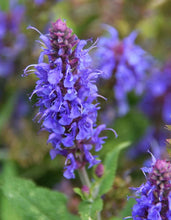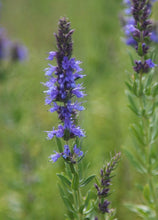Hyssop Seeds - Hyssopus Officinalis
Regular price
$4.00
Sale
Hyssop (Hyssopus officinalis) is a beautiful, well-behaved, easy-to-grow member of the mint family that deserves a place in any herb garden. Older plants form neat, rounded bushes 1 to 3 feet high; younger plants are looser in form. The stiff, erect, typically square stems bear opposite, linear, medium green leaves 1 to 1 1/2 inches long. Tufts of smaller leaves are borne in the leaf axils. Plants are evergreen where winters are mild. Clusters of six to fifteen violet-blue, pink, or white flowers in the upper leaf axils form dense spikes. The two-lipped, tubular corolla is 1/2 inch long and has four protruding stamens that match it in color. The calyx is tubular with five teeth. Plants bloom from summer to fall.
Some botanists recognize a subspecies, H. o. ssp. aristatus, which differs from the species in having bristlelike bracts instead of bladelike ones in the flower spike. The names nurserymen use are variable but generally do not conform to the botanical nomenclature. Cultivars offered for sale include H. o. ‘Rosea’ and ‘Pink Delight’ (pink), ‘Alba’ (white), and ‘Aristatus’ (dwarf). H. o. ‘Sissinghurst’ is a compact form (to 12 inches high) with blue flowers and slightly larger, brighter green leaves.
Native to southern Europe and Eurasia, hyssop came to North America with the early European colonists; the herb is listed among the seeds John Winthrop, Jr., brought to the New World in 1631. Over the years, it has escaped from gardens and is now naturalized at roadsides and in waste places here and there in North America from Quebec to Montana south to North Carolina. It is hardy in zones 3 to 10.
People perceive the odor of hyssop differently. It has been described variously as sweet, not sweet, skunky but not unpleasant, clean and aromatic with a hint of turpentine, medicinal, and minty/camphorous. Some European women are said to sniff hyssop flowers pressed in their psalm books to help them stay awake during church services.
Hyssop is a bee plant par excellence. Legend has it that beekeepers rubbed their hives with hyssop and other herbs to encourage bees to stay. Hyssop also attracts hummingbirds and butterflies; claims that it keeps cabbage butterflies away from crops or repels flea beetles have not been substantiated.
The names hyssop and Hyssopus come from a Semitic word for a different herb. Officinalis means “from the storeroom”, that is, the druggist’s storeroom. Although H. officinalis has no alternate common names, several other plant genera have members that bear the common name hyssop. Among these are Agastache (anise and giant hyssops), Bacopa (water hyssop), Gratiola (hedge hyssop), and Verbena (wild hyssop).
Using Hyssop
Hyssop has been used medicinally for centuries to treat a whole gamut of ailments, from falling sickness (epilepsy) to snakebite. The herb’s medicinal odor probably prompted its use in bouquets to ward off plagues. Gerard recommended gargling a decoction of hyssop and figs for a sore throat and noted, “The same made with figges, water, honie, and rue, and drunken, helpeth the inflammation of the lungs, the old cough, and shortnesse of breath, and the obstructions or stopping of the breast.” Furthermore, a mixture of hyssop, vinegar, and figs might be taken to expel worms.
Other herbalists mentioned using oil preparations of hyssop to kill lice and treat numb joints. Directing the steam from a decoction of hyssop into the ears was said to remedy inflammation or ringing of the ears. Diseased poultry were subjected to the smoke of dried hyssop.
Modern practitioners of herbal medicine prescribe hyssop teas for respiratory illnesses to loosen phlegm, to induce sweating, relieve intestinal gas, and combat rheumatism; the green tops boiled in soup have been used in the treatment of asthma. Infusions and poultices of bruised hyssop tops have been used externally to relieve muscular aches and black-and-blue marks. Research has confirmed that hyssop is soothing to mucous membranes and that the bitter principle in the volatile oil, marrubiin (also present in horehound), has expectorant qualities. Hyssop extracts have shown antiviral activity, especially against herpes simplex, the causative agent of cold sores and genital herpes. The U.S. Food and Drug Administration has put hyssop in its GRAS (generally regarded as safe) category.
Hyssop had more culinary uses in days gone by than it does today. Medieval monks made soups and sauces with it. Its peppery, bitter flavor disguised spoiled meats, and it was thought to aid the digestion of fat. Try small quantities of the chopped fresh leaves or flowers in broths or sprinkled in salad. Hyssop honey, by contrast, is sweet-smelling and delicious; it is said to retain the antiflatulent properties of the herb. The Romans made an herbal wine of hyssop. Today, the oil is used in liqueurs and is an important constituent of Chartreuse and Benedictine.
The oil is also used in perfumery. In the Middle Ages, hyssop tops were strewn on floors to mask bad smells. These days, our housekeeping habits have improved, but we can add the dried leaves with their clean aroma to potpourri, sachets for the linen closet, and laundry rinse water.
Growing Hyssop
In Herbs and the Earth (1935), Henry Beston says of hyssop, “The garden has no more quietly dependable and satisfactory border plant.” His is no idle claim. Hyssop is versatile. It can be grown as a hedge or as a specimen plant. Plant it against a wall or as edging with rue in front, vervain (Verbena officinalis) behind. Contrasting foliage color, shape, and texture make purple sage a superb companion, or try gray, pebbly-leaved catmint, frosty lavender, and glossy-leaved rosemary. The gray filigree of Roman wormwood also admirably sets off the blue flowers and smooth green leaves of hyssop. Tall, wispy-leaved herbs such as dill, fennel, and anise form another kind of contrast. Hyssop is also useful for concealing the bare legs of pink- or white-flowered roses.
Hyssop is easily grown from seeds sown in March or April, or in the fall for germination the following spring. Sow the seeds 1/4 inch deep indoors or out. Germination time is 7 to 10 days. Propagate named cultivars vegetatively. Divide established plants in spring or fall, or take cuttings in spring and root them indoors or in the shade. Hyssop may self-seed. You can move the volunteer seedlings to another spot in the garden or pot them up. Beston notes that hyssop “can be transplanted as casually as one moves a chair.” Transplant seedlings or rooted cuttings to 1 foot apart for a hedge, 18 inches apart in the garden, and water them until they are established. But don’t overwater. Like other Mediterranean herbs, hyssop likes a warm position and light, well-drained alkaline soil. It will tolerate soil as alkaline as pH 8. Full sun is best, but light shade will do. Plants grown in shade will be lankier. Hyssop will flower the first year from seed. It is a good subject for pots or or a window box.
Hyssop needs no winter covering. Prune it hard in spring to encourage new growth. Pinching out the tips of the stems will promote bushier plants; however, heavy shearing of hedges will prevent flowering.
Old-Time Hyssop Tea
Infuse 1/4 ounce of dried hyssop flowers in a pint of boiling water for ten minutes and sweeten with honey—good for “debility of the chest” and “a powerful vermifuge”.
Electuary
Boil honey with hyssop, strain, reboil with aniseed, pepper, ginger, and pulverized roots of licorice, angelica, and elecampane—good for “straightness at the stomach or shortness of breath”.




